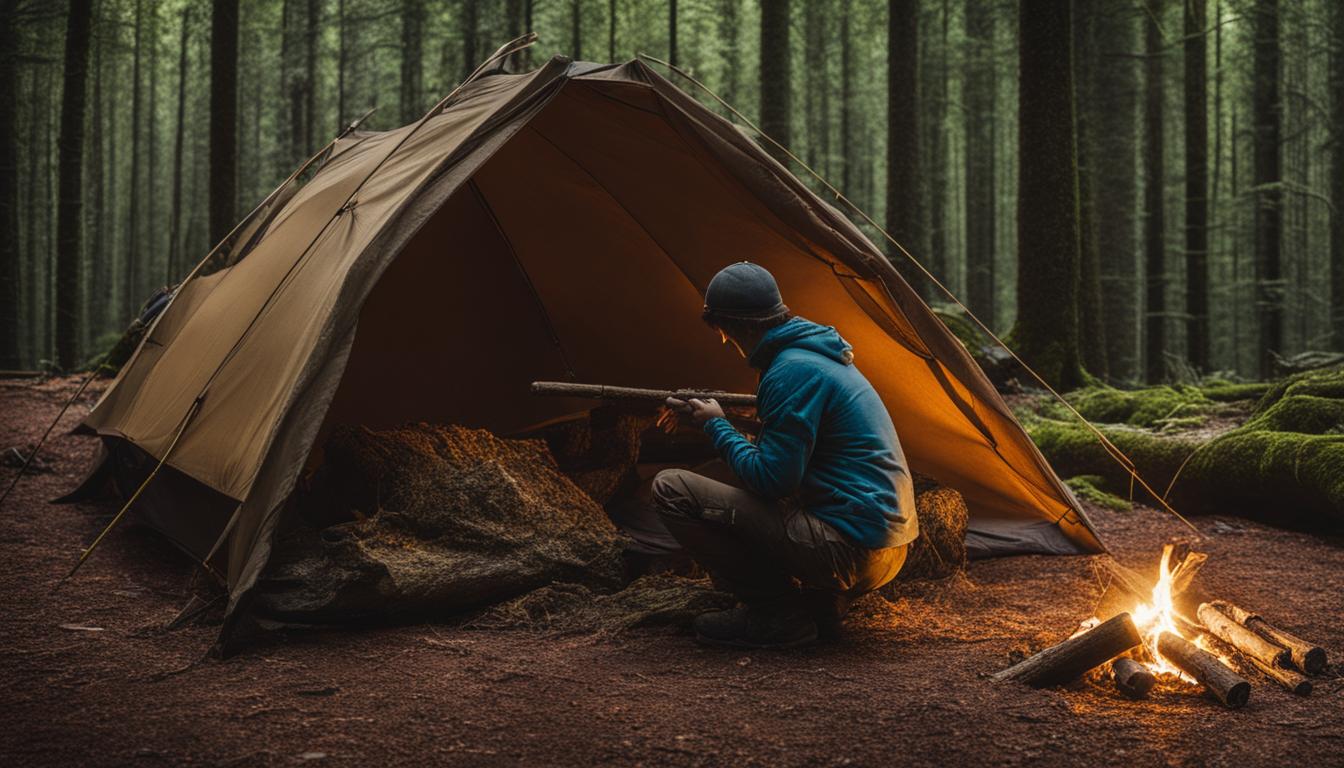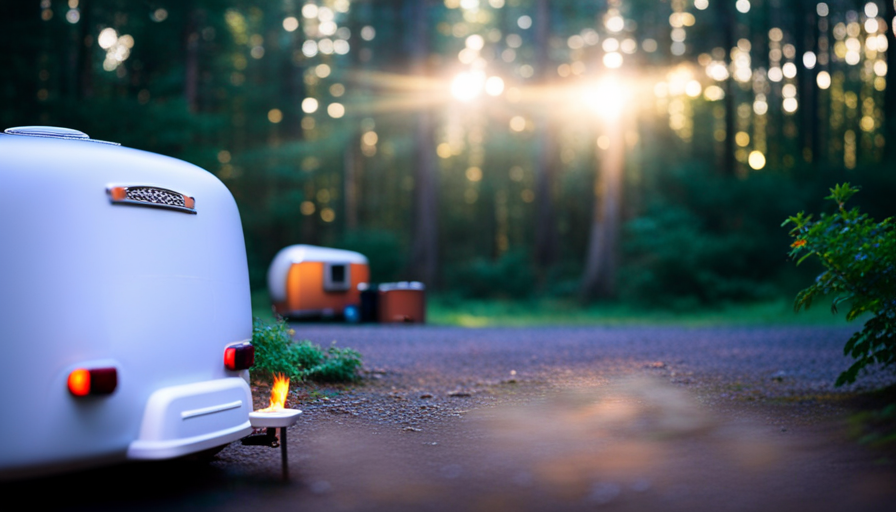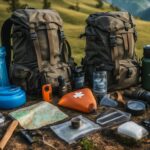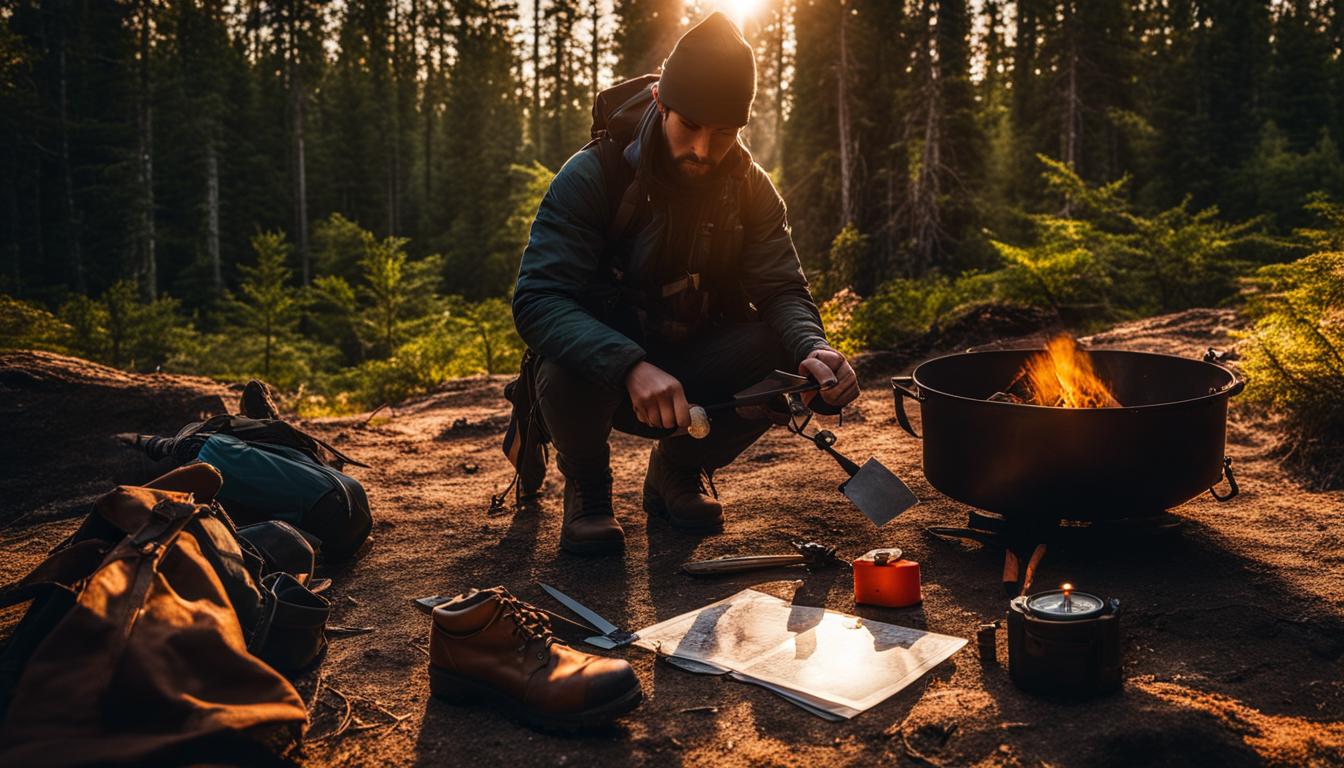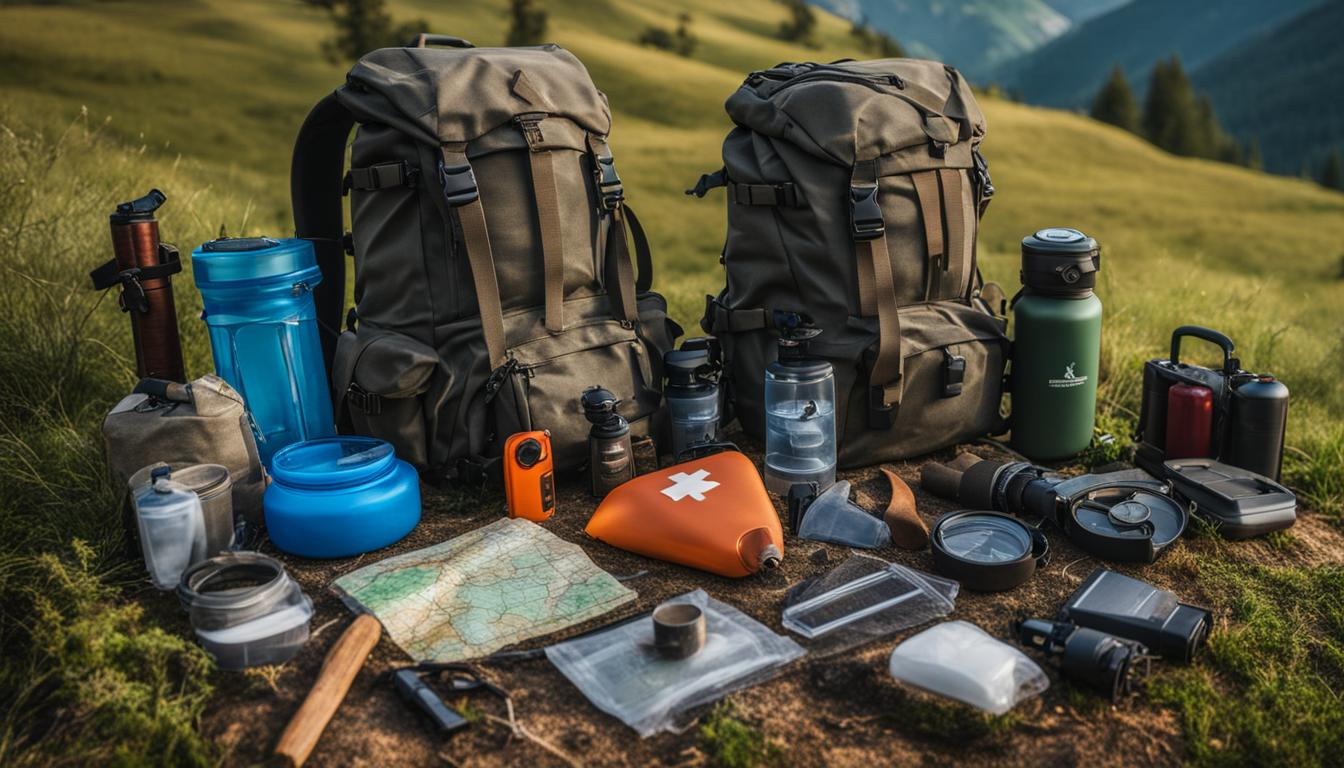Hello, brave explorers! Ready to dive into the wild unknown? If so, you’re in the right place! Throughout this detailed guide, I’ll provide you with the necessary tools to master the outdoors and thrive in any challenging setting. Don’t miss out on this exciting opportunity to enhance your survival skills and embrace the beauty of nature.
From mastering fire-making techniques to building reliable shelters, purifying water, navigating the wilderness, and signaling for help, this guide has got you covered. I will also delve into advanced skills like hunting and foraging, knot-tying, crafting weapons, wilderness first aid, fishing and trapping, and much more.
So, whether you’re a seasoned outdoor enthusiast looking to enhance your skills or a beginner eager to learn the ways of the wild, this guide will provide you with the knowledge and confidence to tackle any challenges that come your way. Join me on this thrilling adventure as we unlock the secrets of the wilderness together!
Key Takeaways:
- Mastering wilderness skills is essential for outdoor survival and adventure
- Key skills include fire-making, shelter building, water purification, navigation, and signaling for help
- Advanced skills like hunting, knot-tying, first aid, weapon-making, and fishing/trapping provide additional self-reliance
- Continuous practice and refinement of wilderness skills is crucial for readiness
- Embrace the freedom of exploring remote areas with confidence and self-reliance
Mastering Fire-Making: Essential Wilderness Skill
Fire-making is a fundamental skill that every wilderness adventurer should master. Whether you’re camping, hiking, or surviving in the wild, being able to start a fire can mean the difference between warmth, safety, and even life and death. In this section, I will guide you through the essential steps and techniques for mastering the art of fire-making in the wilderness.
“Fire is the heart of the camp, the life of the journey. Without it, we are lost in the darkness, both literally and metaphorically.” – Unknown
When it comes to fire-starting methods, there are various techniques you can employ, each with its own advantages and challenges. Flint and steel, for example, is a classic fire-starting method that relies on striking a hardened steel against a piece of flint to create sparks. Other friction-based methods, such as the fire plow or bow drill, require more physical effort but can be extremely effective once mastered.
However, it’s essential to remember that fire safety should always be a top priority in the wilderness. Before starting a fire, make sure you have selected a suitable location away from flammable materials and have cleared the area of any potential hazards. Always have a reliable source of water nearby to extinguish the fire properly and ensure that it is completely out before leaving the area.
Fire Making Methods Comparison
Building a Reliable Wilderness Shelter
When venturing into the wilderness, one of the most crucial skills to have is the ability to build a reliable shelter. A sturdy and well-constructed shelter can protect you from harsh weather conditions, provide a sense of security, and ultimately increase your chances of survival. In this section, I will guide you through the basics of shelter building, including selecting a suitable location, gathering appropriate materials, and constructing various types of shelters.
Scouting for the Optimal Location
Before starting to build your shelter, it is essential to choose the right location. Look for an area that is relatively flat, away from potential hazards like falling trees or flooding, and preferably close to natural resources such as a water source or firewood. Make sure the ground is not damp or prone to pooling water, as this can lead to discomfort and potential health risks.
Gathering Suitable Materials
Next, you’ll need to gather materials for your shelter. Depending on the environment and the resources available, you can use a variety of materials such as branches, leaves, grass, bark, or rocks. These materials can be used to construct different types of shelters, including lean-tos, tarp tents, and natural rock formations. It is important to choose materials that are readily available and suitable for the type of shelter you intend to build.
| SHELTER TYPE | MATERIALS |
|---|---|
| Lean-to | Long branches, logs, leaves, and debris |
| Tarp Tent | Tarp or sturdy fabric, ropes, stakes |
| Natural Rock Formation | Large rocks, smaller stones for insulation |
Constructing Your Wilderness Shelter
Once you have found a suitable location and gathered the necessary materials, it’s time to construct your shelter. The construction process will vary depending on the type of shelter you choose. Lean-tos, for example, involve propping up a long branch against a tree or sturdy object and layering smaller branches, leaves, and debris on top for insulation. Tarp tents require securing the tarp or fabric between trees or using stakes and ropes. Natural rock formations involve stacking large rocks to create a protective structure.

Remember, practice makes perfect when it comes to shelter building. Take the time to familiarize yourself with different types of shelters and experiment with various materials and techniques. By mastering the skill of building a reliable wilderness shelter, you can ensure your safety and comfort in any outdoor adventure.
Ensuring Clean Drinking Water: Wilderness Water Purification
In the wilderness, access to clean drinking water is essential for your survival. Without a reliable source of safe water, dehydration and waterborne illnesses can quickly become life-threatening. In this section, I will guide you through the process of wilderness water purification, ensuring that you can stay hydrated and healthy during your outdoor adventures.
Identifying Drinking Water Sources
First, it is crucial to know how to identify viable drinking water sources in the wilderness. Lakes, rivers, and springs are often available, but not all water sources are safe to drink from. Look for clear, flowing water whenever possible, as stagnant water may be contaminated. Avoid water sources near industrial areas, livestock operations, or areas with potential chemical contamination.
Remember, even if a water source appears clean, it may still contain harmful bacteria, parasites, or viruses. It is always safer to purify the water before consumption.
Water Filtration and Purification Methods
There are various methods you can use to purify water in the wilderness. Here are some common techniques:
- Boiling water: Boiling water for at least one minute can kill most microorganisms, making it safe to drink. However, boiling does not remove chemical contaminants.
- Water filtration: Using a portable water filter can effectively remove bacteria, protozoa, and some viruses from the water. Look for filters with a “microfiltration” or “ultrafiltration” system, as they provide the highest level of filtration.
- Chemical disinfection: Water purification tablets or drops containing chlorine or iodine can kill harmful microorganisms. Follow the instructions on the product label for proper use.
- UV sterilization: UV light can be used to kill bacteria, viruses, and protozoa. Portable UV sterilizers are available for wilderness use, but they require batteries or a power source.
It is important to note that these methods may not remove chemical contaminants or certain types of parasites. If you suspect the water source may contain chemical pollutants or viruses, it is best to use multiple purification methods or seek an alternative water source.
Outdoor Hydration Tips
Staying properly hydrated is crucial for your overall well-being in the wilderness. Here are some tips to help you maintain optimal hydration:
- Drink water regularly, even if you do not feel thirsty. Thirst is not always an accurate indicator of hydration.
- Carry an adequate supply of water or a suitable water container with you at all times.
- Plan your water consumption based on your activity level and the environmental conditions. In hot weather or during intense physical exertion, you may need to drink more water.
- Consider using electrolyte tablets or adding a pinch of salt to your water to help replenish lost minerals during strenuous activities.
- Avoid consuming untreated water from unknown sources to prevent waterborne illnesses.
By implementing these water purification methods and following proper hydration practices, you can ensure that you have a safe and reliable source of drinking water during your wilderness adventures.
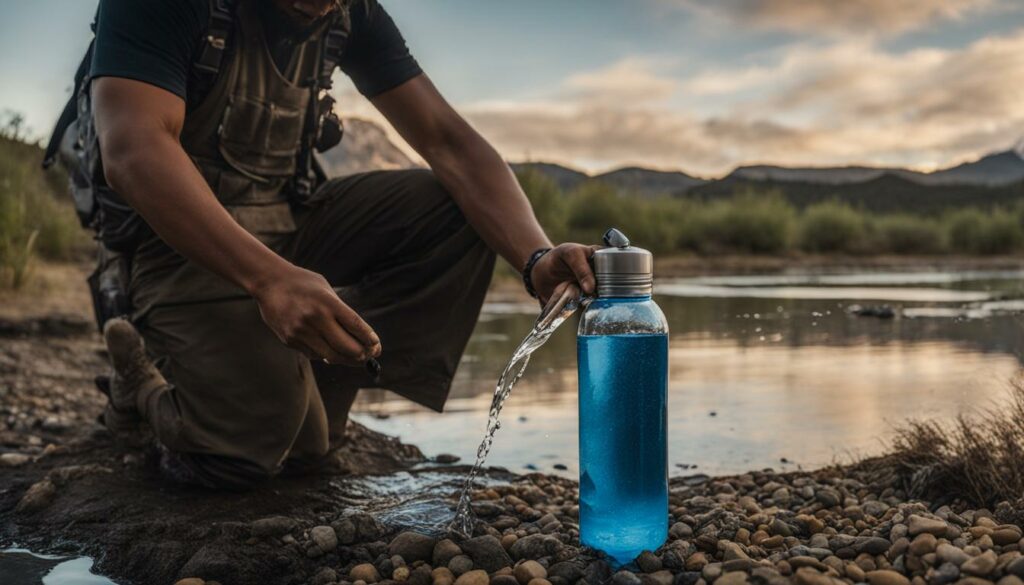
Navigating the Wilderness: Outdoor Navigation Skills
When venturing into the wilderness, having reliable outdoor navigation skills is crucial to ensure your safety and reach your desired destinations. Through the use of compasses, maps, and celestial markers, you can navigate through unfamiliar terrain and find your way back to civilization. In this section, I will introduce you to the essential techniques and tools for successful outdoor navigation.
Compass Navigation
Compasses are an indispensable tool for wilderness navigation. By using a compass, you can determine your direction of travel and stay on course. Start by aligning the compass with the magnetic north, allowing the needle to settle, and then rotate the compass housing until the orienting arrow aligns with the magnetic needle. This will give you an accurate reading of your direction. Remember to adjust for declination, which accounts for the difference between magnetic north and true north in your location.
Celestial Navigation
When the compass is not enough, you can rely on celestial navigation to guide you. By observing the sun, moon, stars, and other celestial bodies, you can determine your direction and approximate time. The sun is particularly useful for navigation during the day. In the northern hemisphere, the sun appears in the southern part of the sky, while in the southern hemisphere, it appears in the northern part. By paying attention to the sun’s position and movement, you can maintain a general sense of direction.
Wilderness Orientation
Being able to read the landscape and understand natural features is an essential skill for wilderness orientation. Look for distinctive landmarks such as mountains, rivers, and rock formations that can help you maintain your bearings. Pay attention to the contour lines on the map, which indicate changes in elevation. By correlating the features on the map with what you see in the wilderness, you can navigate more accurately and make informed decisions about your route.
Table: Navigation Tools
| Tool | Description |
|---|---|
| Compass | An instrument with a magnetic needle that points towards magnetic north, helping you determine your direction of travel. |
| Maps | Printed or digital representations of an area that provide valuable information about the terrain, landmarks, and trails. |
| Celestial Bodies | The sun, moon, stars, and planets can serve as navigational aids by providing information about direction and time. |
| Landmarks | Prominent features in the landscape that can help you maintain your bearings and navigate through the wilderness. |

“The wilderness holds answers to more questions than we have yet learned to ask.” – Nancy Newhall
Signaling for Help: Communicating in the Wilderness
In case of an emergency, it is vital to have the ability to signal for help in the wilderness. When you find yourself in a precarious situation, being able to communicate your distress can greatly increase your chances of rescue. In this section, I will guide you through various signaling methods and devices that can be used to attract attention and alert others to your presence.
Signaling Devices
There are several signaling devices that can be effective in wilderness rescue situations. One such device is a whistle. A loud, high-pitched whistle can carry over long distances and is easily recognized as a signal for help. Another useful tool is a mirror. By reflecting sunlight, you can create a highly visible flash that can be seen by search and rescue teams or passing aircraft. Additionally, a flashlight or strobe light can be used to create a blinking signal that catches the attention of potential rescuers.
Morse Code
When using signaling devices, it is important to establish a clear and recognizable sequence that can be easily interpreted. One commonly used sequence is the international distress signal of “S.O.S.” This signal is sent in Morse code, a communication system that uses combinations of short and long signals to represent letters of the alphabet. So, by flashing three short signals, followed by three long signals, and then three short signals again, you’ll be sending the universal distress call for help.
| Signal | Morse Code |
|---|---|
| Short Signal | . |
| Long Signal | – |
Backup Options
While signaling devices are effective, it is crucial to have backup options in case these devices fail or are unavailable. For example, you can create visible smoke signals by adding green vegetation like pine needles or leaves to your campfire. This will generate thick smoke that can be seen from a distance. In addition, if you are near water, you can use a brightly colored flag or piece of clothing to attract attention. Remember to choose colors that contrast with the natural surroundings to ensure maximum visibility.
By mastering the art of signaling for help in the wilderness, you can greatly increase your chances of being rescued in an emergency situation. Whether using signaling devices like whistles and mirrors, learning Morse code to send distress signals, or utilizing smoke and bright colors as backup options, effective communication is essential for wilderness safety. Stay prepared and always have a plan in place to ensure that you can attract attention and get the help you need when it matters most.

Advanced Wilderness Skills: Hunting and Foraging
As an outlaw of the wilderness, I understand the importance of hunting and foraging for sustenance in the wild. When venturing into the great outdoors, it’s essential to have the knowledge and skills to find and procure your own food. Mastering these advanced wilderness skills not only ensures your survival but also connects you with the primal instincts of our ancestors.
When it comes to hunting, precision and patience are key. I’ve honed my skills in tracking game and setting traps to catch small animals. By understanding animal behavior and reading signs in the environment, I increase my chances of a successful hunt. Whether it’s setting snares or using primitive weapons like slingshots, I embrace the challenge of acquiring protein sources in the wild.
Foraging, on the other hand, allows me to tap into the abundant resources provided by nature itself. I’ve learned to identify edible plants and fungi, ensuring that my meals are not only nutritious but also safe. From wild berries and mushrooms to edible roots and leaves, the wilderness offers a diverse range of natural sustenance. It’s crucial to research and understand the local flora and fauna to avoid any potential hazards.
Benefits of hunting and foraging:
- Self-sufficiency: By mastering hunting and foraging skills, I reduce my reliance on store-bought supplies and embrace a self-reliant lifestyle in the wilderness.
- Nutritional diversity: Hunting and foraging allow me to enjoy a wider range of food options than what is typically available through traditional means.
- Environmental awareness: These skills foster a deeper understanding and appreciation for nature, as I learn to coexist with the ecosystem and practice sustainable harvesting.
- Physical and mental challenges: Engaging in hunting and foraging activities provides a sense of accomplishment and satisfaction, boosting both physical fitness and mental resilience.
Remember, hunting and foraging should always be done responsibly and ethically. Respect the natural balance of the environment, adhere to legal regulations, and never exploit or harm endangered species. By embracing these advanced wilderness skills with reverence and care, you can fully immerse yourself in the wild and experience the primal thrill of sourcing your own sustenance.

Knot-Tying: Practical Skill for Wilderness Survival
When it comes to wilderness survival, one cannot underestimate the importance of knot-tying skills. Mastering essential knots is crucial for various tasks, such as shelter construction and tool making. Whether you’re improvising a shelter using natural materials or securing equipment in the great outdoors, having a solid repertoire of knots is a must.
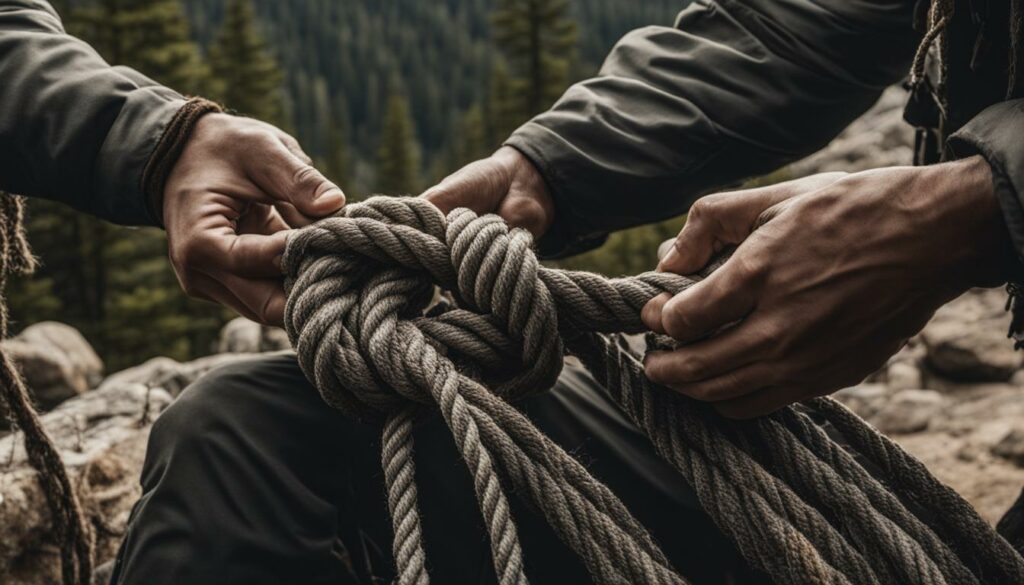
To start your journey in knot-tying, there are a few essential knots you should familiarize yourself with. One such knot is the square knot, also known as the reef knot. This versatile knot is used for joining two ropes of equal diameter, making it ideal for securing your shelter’s corners or bundling sticks together for tool making.
Another valuable knot is the clove hitch. This knot is perfect for attaching ropes to trees or poles, allowing you to create sturdy structures, hang gear, or even hoist food away from wildlife. With its simple yet effective design, the clove hitch is a valuable addition to any wilderness adventurer’s skillset.
Lastly, the bowline knot is a handy knot for creating a secure loop at the end of a rope. This knot is especially useful when constructing a shelter, as it enables you to create a ridge line, secure tarps, or hang gear. Its strength and stability make it an essential knot for wilderness survival.
Essential Knots for Wilderness Survival
- Square Knot (Reef Knot)
- Clove Hitch
- Bowline Knot
These three knots form the foundation of knot-tying skills and will serve you well in a variety of wilderness scenarios. Practice tying them until you can do so confidently without hesitation. Remember, the key to knot-tying mastery is repetition and muscle memory.
By becoming proficient in knot-tying, you’ll be equipped with a practical skill that enhances your ability to construct reliable shelters, create tools, and secure essential equipment. With these skills in your repertoire, you’ll be well-prepared to tackle the challenges of the wilderness and embrace the freedom of self-reliance.
| Knot | Common Use | How to Tie |
|---|---|---|
| Square Knot (Reef Knot) | Joining two ropes of equal diameter | 1. Cross the right end over the left end.
2. Bring the right end under the left end and pass it through the loop created. 3. Tighten the knot by pulling both ends simultaneously. |
| Clove Hitch | Attaching ropes to trees or poles | 1. Wrap the rope around the object.
2. Cross the rope over itself to create an X. 3. Pass the end of the rope under the X and pull it tight. |
| Bowline Knot | Creating a secure loop at the end of a rope | 1. Create a small loop near the end of the rope.
2. Pass the end of the rope through the loop. 3. Bring the end of the rope around the standing part and back through the loop. 4. Tighten the knot by pulling the standing part and the end of the rope simultaneously. |
Crafting Weapons: Defense in the Wilderness
When venturing into the wilderness, it’s important to be prepared for any potential danger that may arise. In some situations, having a means of defense against predators or other threats can mean the difference between life and death. That’s why mastering the art of weapon-making is a crucial skill for wilderness survival.
One effective and easily crafted weapon is the slingshot. With a few basic materials found in the wilderness or easily acquired, you can create a reliable tool for self-defense. The slingshot is a versatile weapon that can be used to throw stones or other projectiles with impressive accuracy and force.
Building a slingshot starts with finding a Y-shaped branch or forked piece of wood. The fork should be sturdy, and the wood should be strong enough to withstand the tension of the slingshot. Attach a length of rubber tubing or elastic to the fork, creating the sling. This will serve as the launching mechanism for your projectiles.
Practice your aim and shooting skills regularly to become proficient with your slingshot. Start by using small stones or projectiles, gradually increasing the weight and size as you become more comfortable and skilled. Remember to always prioritize safety and avoid using your slingshot in a reckless or harmful manner.

Stay Safe and Confident
While crafting weapons may not always be necessary or legal in certain areas, knowing how to create improvised weapons such as a slingshot can provide you with an added sense of security in the wilderness. However, it’s essential to use these tools responsibly and ethically, only utilizing them for self-defense when absolutely necessary.
Remember, your best defense in the wilderness is your knowledge and preparation. Always prioritize prevention and avoidance strategies to minimize the need for self-defense. Stay aware of your surroundings, learn about the behavior of local wildlife, and take precautions to minimize encounters with potentially dangerous animals.
By mastering the skill of weapon-making, you can enhance your confidence and self-reliance in the wilderness. However, it’s crucial to approach this skill with respect and a clear understanding of the potential consequences. Your safety and the preservation of nature should always be the top priorities in any wilderness adventure.
Reliable Wilderness First Aid Skills
When venturing into the wilderness, it is crucial to be prepared for any unexpected injuries or emergencies that may arise. Having reliable wilderness first aid skills can make all the difference in ensuring the safety and well-being of yourself and others. From basic wound care to life-saving interventions, being equipped with the knowledge and tools for emergency medical care is essential.
Here are some essential wilderness first aid skills to master:
1. Basic Wound Care
Being able to properly clean and dress wounds in the wilderness is crucial to prevent infection and promote healing. Carry a well-stocked first aid kit with antiseptic solutions, sterile dressings, and adhesive bandages. Remember to clean wounds thoroughly with clean water or antiseptic wipes before applying dressings.
2. CPR and Rescue Breathing
In a life-threatening situation, knowing how to perform cardiopulmonary resuscitation (CPR) and rescue breathing can save a person’s life. Familiarize yourself with the correct techniques and practice regularly to maintain proficiency. Carry a barrier device in your first aid kit to protect yourself while providing rescue breathing.
3. Fracture and Sprain Management
When someone sustains a fracture or sprain in the wilderness, it is important to immobilize the injured area to prevent further damage. Learn how to properly splint and stabilize fractures and sprains using available materials such as sticks, bandages, or clothing. Prioritize minimizing movement and seek medical help as soon as possible.
4. Heat and Cold-Related Illnesses
Extreme temperatures can pose serious health risks in the wilderness. Learn how to identify and manage heat-related illnesses such as heat exhaustion and heatstroke, as well as cold-related illnesses like hypothermia and frostbite. Prevention is key, so dress appropriately for the weather and stay hydrated and nourished.
5. Wilderness-specific Injuries
Outdoor activities come with their own set of risks and injuries. Familiarize yourself with the management of common wilderness-specific injuries, such as snake bites, insect stings, and animal encounters. Carry a snake bite kit, insect repellent, and knowledge on how to react in case of an encounter with wildlife.
Remember, these wilderness first aid skills are meant to provide immediate care and stabilize the injured person until professional medical help can be reached. It is essential to continually educate yourself and practice these skills to ensure readiness in emergency situations. By being prepared, you can confidently navigate the challenges of the wilderness and keep yourself and others safe.
Fishing and Trapping: Sustenance in the Wild
When venturing into the wild, knowing how to procure food is essential for survival. Fishing and trapping skills are valuable assets that allow me to sustain myself with protein-rich sources found in the great outdoors. By honing these skills, I can secure a steady supply of food even in the most remote areas.
Fishing is a time-tested method of catching fish, an abundant and nutritious food source. Whether casting a line into a tranquil river or ice fishing on a frozen lake, I rely on my knowledge of bait selection, proper technique, and understanding the habits of different fish species. This expertise enables me to reel in a bountiful catch and satisfy my hunger.
Trapping is another skill that has served me well in the wild. By strategically setting snares and traps, I can capture small game such as rabbits, squirrels, or birds. This method provides a renewable source of protein while minimizing effort and conserving energy. I prioritize ethical trapping practices, ensuring that I do not deplete local wildlife populations and respect the delicate balance of nature.

Table: A Comparison of Fishing and Trapping
| Fishing | Trapping | |
|---|---|---|
| Ease of Procurement | Requires knowledge of fishing techniques and equipment. Success can depend on factors such as weather conditions and the availability of fish. | Requires knowledge of trapping techniques and understanding animal behavior. Success can depend on identifying proper trap locations and setting traps effectively. |
| Diversity of Potential Prey | Offers a wide variety of fish species, each with its own nutritional value and taste. | Captures small game such as rabbits, squirrels, and birds. Provides a range of protein sources. |
| Sustainability | When practiced responsibly, fishing can be a sustainable method of acquiring food. Adhering to catch limits and fishing seasons helps preserve fish populations. | Proper trapping techniques and ethical practices ensure minimal impact on wildlife populations. |
| Environmental Adaptability | Fishing can be pursued in various aquatic environments, from freshwater lakes and rivers to saltwater oceans and coastal areas. | Trapping can be employed in a wide range of habitats, including forests, grasslands, and even desert regions. |
By combining fishing and trapping techniques, I create a well-rounded approach to procuring sustenance in the wild. Leveraging these skills ensures my survival in remote areas with limited food resources. While mastering these methods requires practice and patience, the rewards are well worth the effort.
Conclusion: Becoming a Master of Wilderness Skills
Well, partner, you’ve done it! You’ve conquered the wild and emerged as a true master of wilderness skills. With fire-making, shelter building, water purification, navigation, signaling, and a whole range of additional skills under your belt, you’re now a force to be reckoned with in the great outdoors.
But this ain’t the end of the road for you, cowboy. The path to outdoor self-reliance is a journey that never truly ends. It’s all about honing your skills, perfecting your techniques, and embracing the confidence that comes with being a wilderness survivor.
So, saddle up and keep practicing, keep refining, and keep that survival confidence burning bright. With each step forward, you’ll become more attuned to the ways of the wild, more self-reliant, and more ready for any challenge that Mother Nature throws your way. Embrace your inner outlaw spirit, and let it guide you as you continue to explore remote areas and embrace the freedom of the wilderness.
Remember, partner, mastery of wilderness skills isn’t just about conquering nature—it’s about connecting with it on a deeper level. So go forth, embrace the wilds, and let your self-reliance shine like a beacon in the night. Adventure awaits, and you’re more than ready to embrace it with open arms.
What Wilderness Skills are Essential for Outdoor Survival?
When it comes to outdoor survival, an expert outdoor skills mastering guide can be invaluable. Essential wilderness skills such as fire-building, first aid, navigation, shelter-building, and foraging are crucial for staying safe in the wilderness. With the right skills and knowledge, you can confidently navigate and survive in the great outdoors.
FAQ
What are the essential wilderness skills for survival?
The essential wilderness skills for survival include fire-making, shelter building, water purification, navigation, signaling for help, hunting and foraging, knot-tying, weapon-making, wilderness first aid, and fishing and trapping.
How can I start a fire in the wilderness?
To start a fire in the wilderness, you can use various techniques such as flint and steel or friction-based methods. It is important to select a suitable location, gather firewood, and practice fire safety to prevent forest fires.
What are the basics of shelter building in the wilderness?
The basics of shelter building in the wilderness include scouting for an optimal location, gathering suitable materials, and using tools or improvising if necessary. Different types of shelters, such as lean-tos, tarp tents, and natural rock formations, can be constructed to protect yourself from the elements.
How can I purify water in the wilderness?
To purify water in the wilderness, you can use methods such as boiling, filtering through natural materials like charcoal and sand, and making use of solar stills. It is important to identify viable water sources and collect and purify water to ensure your hydration needs are met.
How can I navigate in the wilderness?
To navigate in the wilderness, it is important to carry navigation tools such as maps, compasses, and GPS trackers. You can effectively use these tools to track your location and reach your desired destinations. Alternative navigation methods, such as using celestial markers and reading the landscape, can also be helpful.
How can I signal for help in the wilderness?
You can signal for help in the wilderness using various devices and techniques, including whistles, mirrors, flashlights, and creating visible smoke from a campfire. Establishing a clear signaling sequence, such as “S.O.S.” using Morse code, is important, as well as having backup options in case of device failure.
What are some advanced wilderness skills I can learn?
Some advanced wilderness skills you can learn include hunting and foraging for food, mastering knot-tying for various purposes, crafting weapons for defense against predators, acquiring wilderness first aid skills to handle emergencies, and utilizing fishing and trapping techniques to provide sustenance in the wild.
How can I become proficient in knot-tying?
To become proficient in knot-tying, you can learn essential knots for various purposes such as securing your shelter, setting snares, and constructing tools. Practice tying secure knots and understand their applications in the wilderness to enhance your survival capabilities.
How can I craft weapons for defense in the wilderness?
You can craft simple weapons such as slingshots using basic materials found in the wilderness or easily acquired. Constructing a slingshot and practicing your aim and shooting skills can enhance your confidence and sense of security in the wilderness.
What wilderness first aid skills should I learn?
Some wilderness first aid skills you should learn include CPR, controlling bleeding, treating burns, stabilizing limbs, and providing relief for insect stings and abrasions. Practice these skills with a partner and understand the importance of prompt medical care in handling emergencies in the wilderness.
How can I obtain food in the wilderness?
To obtain food in the wilderness, you can learn trapping techniques for small game and various fishing methods. Understanding the different methods and adapting them to the specific environment and prey available will ensure your survival in remote areas with limited food resources.

